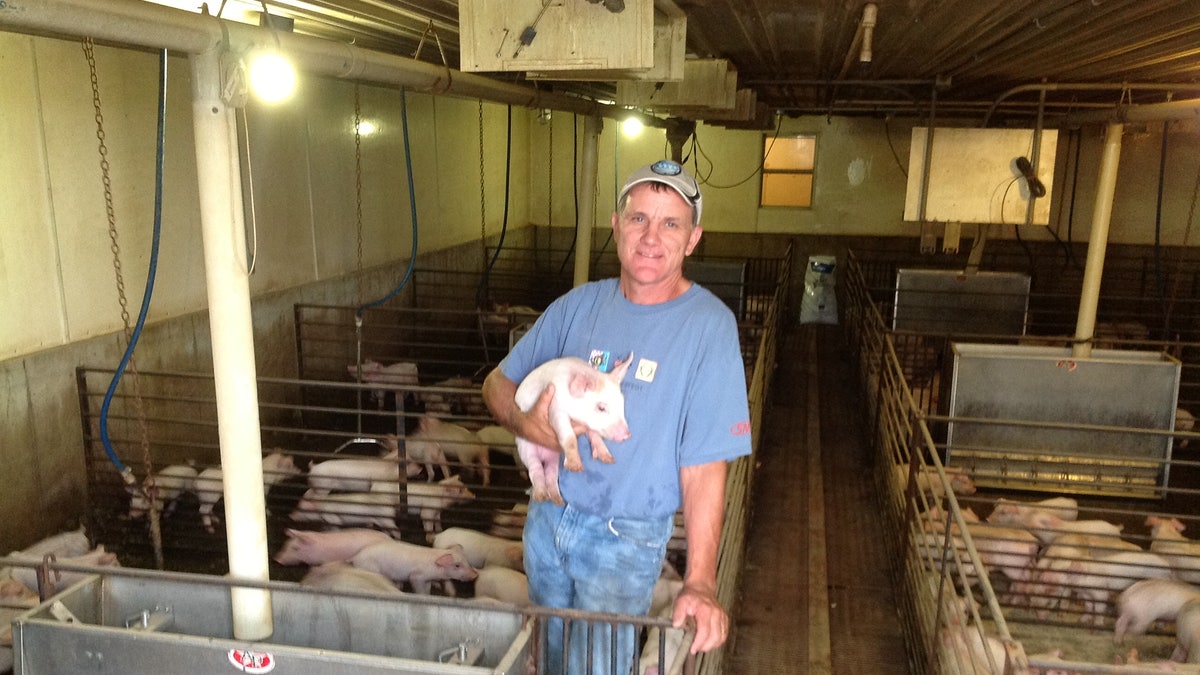
Bill Luckey hopes to be able to prevent future outbreaks of PEDv on his farm with improved bio-security measures.
Bill Luckey, 59, estimates he has been working in the hog farming industry for 55 years – including the time he spent helping his dad on their family’s hog farm as a small child.
But since the Porcine Epidemic Diarrhea Virus (PEDv) hit the 600-head sow farm in Columbus, Neb., where Luckey is a partner, he said he’s faced challenges unlike any he’s seen in his years in the industry.
“We’ve gone through…different diseases, but a lot of those it seems you can work your way through them and keep rolling,” Luckey told FoxNews.com. “Where with this one, in talking to other producers, some of these guys still have an occurrence 20 to 30 weeks after the initial outbreak and still have a litter once in a while that breaks…It’s just frustrating from standpoint of we don’t know a lot about it.”
According to the U.S. Department of Agriculture (USDA), PEDV has killed approximately 7 million piglets in the U.S. since it was first identified in May 2013. PEDv is a coronavirus affecting swine, which causes diarrhea and vomiting. While adult pigs can become infected, the virus primarily targets piglets, and can have up to a 100 percent fatality rate. The virus does not affect edible pork products, and is not a threat to human health.
Luckey said PED-V first hit his farm in December 2013, causing them to lose a full turn of production – between 1,500 and 2,000 baby pigs.
“When you lose basically six to eight weeks of production, that means I have a pretty big hole in my operation,” Luckey said.
Other farmers throughout the Midwest have faced similar losses. Phil Borgic, 57, has been working in pork production for 40 years. When PEDv hit his farm in Nokomis, Ill., in January, he lost about 10 percent of his production for the year.
“It looked to be a good year starting out and now we’re going to be selling a minimum of 10 percent less for the year,” Borgic told FoxNews.com.
Borgic said he had been preparing for the virus to hit his farm. After it hit, he quickly encouraged the spread of the disease throughout his sows, hoping they would develop antibodies to the virus. However, it’s still unclear how long maternal antibodies to PEDv last – and Borgic said he’s prepared for a re-break of the disease.
“I’m not very optimistic that we’re going to be able to control it going into the winter again,” Borgic said. “But I’m hopeful we have a much lower incidence rate and the sow farms that do contract it will not have near the losses that we’ll have this past winter.”
On June 5, 2014, the USDA announced $26.2 million in funding to combat the spread of PEDv. The money will go towards supporting hog farmers in increasing their bio-security efforts, towards diagnostic testing and to support management and control of the disease. Other funds will be used to develop a vaccine for the disease and to be used for research into PEDv. While a vaccine was recently approved to fight PEDv, its effectiveness remains to be seen.
However, reports from veterinarians warn that the disease could worsen going into the winter months – and many questions linger as to the best ways to prevent and contain the disease, or why it affects some farms but not others.
Luckey said though he had been aware that PEDv was in the U.S., his farm was one of the first in Nebraska to be affected – taking him by surprise.
“We still don’t know where it came from, because we’re sort of isolated and it seemed strange as to why we got it,” Luckey said. “And so we’ve changed some protocols …we hope it does some good, we’ll find out with summer months coming on and warmer weather, hopefully the spread of this will slow down.”
While both Borgic and Luckey said their business will suffer this year, the higher price of pork will ease their losses. Both have made changes on their respective farms, including improving bio-security by implementing more thorough sterilization techniques in barns and in vehicles used to transport pigs.
“Right now, the pig health is very good, probably better than ever and that might just be because of the increased bio-security, cleaning buildings better, disinfecting twice, whatever it may be and being a little more aware of what’s going on and doing a little better job with the bio-security in the barns,” Luckey said.
However, the lack of information about the origins of the PEDv outbreak, and how best to control it, remains frustrating for those in the hog farming industry.
“Basically, we’re going to need research dollars to research a cure for something like this,” Luckey said. “But also we’re going to have to have coordination between the diagnostic labs so if there is an outbreak, communication can be rapidly put out through the whole industry as to what’s out there so we know what to look for right away instead of wondering, ‘What this is?’
